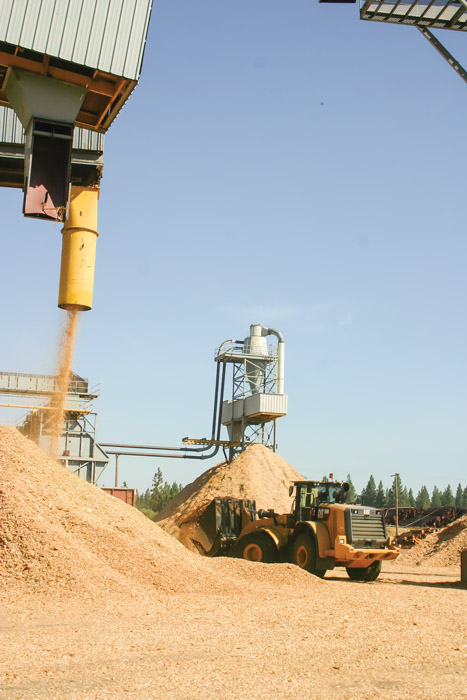After starting up initially as a pure power producer in December 2010, Roseburg Forest Product Co.’s cogeneration combined heat and power plant (CHP) completed an internalization project six months later that now has the facility providing electricity to power the company’s longtime veneer plant on-site, while also delivering steam used in veneer production processes.
In addition to powering the veneer plant independently, the biomass cogeneration facility also provides a sustainable energy source to help California meet renewable energy objectives enacted several years ago. The biomass plant is also a much-needed utilization facility as a destination for biomass material produced from the region’s considerable public timberlands as well as private holdings in need of thinning and understory removal.
Announced in 2006 by Roseburg officials and approved in 2008 by local county commissioners and agencies, the biomass project was challenged by environmental organizations and ultimately approved in fall 2010. (In fact, the project’s delay allowed the biomass facility to qualify for significant tax credits that were part of federal legislation addressing the economic downturn of 2008-2009.)
During the appeals process challenging the facility, it was also noted that Roseburg’s biomass plant has the added benefit of stabilizing Pacific Power’s main line and grid, which has a terminal point in nearby Lakehead, Calif. south of Weed. Having a facility like Roseburg’s in such a location helps provide a buffer for fluctuations and stabilizes overall grid quality, officials said.
The cogen plant’s General Electric turbine is rated for 12 MW output, while the generator is rated at 15 MW. At any given time, depending on power usage at the veneer plant, the cogen facility is providing 3-10 MW to the power grid.

Background
The overall facility dates to 1983, when Roseburg opened the veneer plant. During a major plant renovation in 1997, a new boiler was added, and company officials designed the powerhouse facility with enough room to eventually accommodate a turbine and generator.
Once the decision was made to go ahead with the project in 2006, the company added the generator and turbine, which is a traditional condensing unit. Several months later the turbine was modified with extraction point and diaphragm to pull steam for veneer plant processes, and a super heater added to the top of the boiler. Switchgear equipment was also added to power the plant.
“Originally, when the project was done we were going to sell 100% of our output to the grid,” says Plant Manager Jeff Scholberg. “By putting in the internalization equipment we were able to power the entire plant off the cogeneration, which resulted in a savings. And since we’re always producing more than we’re consuming, we’re now a net seller.”
The biomass feeding the cogeneration plant is separated among three primary sources: residuals from the veneer plant, biomass produced from logging activities on Roseburg’s extensive northern California timberlands (more than 175,000 acres) and biomass purchased on the open market. On-site processing equipment for biomass includes a Jeffrey hog.
An extensive fuel handling and storage area gives the facility maximum fiber flexibility, keeping hog fuel biomass separate from clean chips, which may be sold to composite plants or even exported from Roseburg’s Pacific Coast chip export facilities depending on overall market conditions. The boiler is fed through an 1,000 unit Atlas fuel storage bin.
During a celebration marking Roseburg’s 75th anniversary last year, President Allyn Ford said he was particularly proud of the Weed facility’s biomass CHP project and the way it adds to overall forest products utilization and efficiency—and also aids healthy forest management projects while creating cost-efficient, renewable energy. “The process goes round and round, it’s very efficient and it makes a lot of sense,” Ford said.